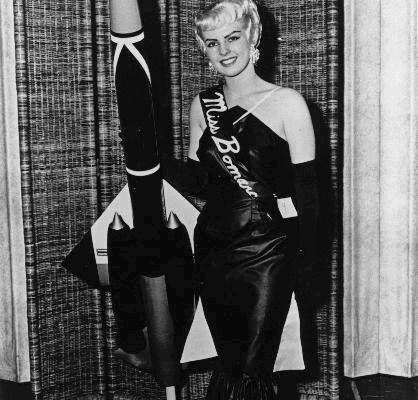Fran Frost , Miss Bomarc Interceptor Missile, ladies and gentlemen.
Fran Frost , Miss Bomarc Interceptor Missile, ladies and gentlemen.
The missile is the supersonic Bomarc anti-aircraft missile developed by Boeing and the University of Michigan Aeronautical Research Center. The woman is 18-year-old Fran Frost. The year was 1958.
The Hill Top Times, newspaper of Hill Air Force Base, offered the following coverage:
Fran Frost went on to be Miss Utah State Fair, Miss Dairy Queen, and Miss World Contact Lens, but then retired from modeling.
Read her full story at Conelrad Adjacent.
https://www.weirduniverse.net/blog/comments/miss_bomarc_interceptor_missile
BOMARC Site RW-01 is a 75-acre (30 ha) fenced-off site contaminated primarily with « weapons-grade plutonium (WGP), highly-enriched and depleted uranium. » On 7 June 1960 an explosion in a CIM-10 Bomarc missile fuel tank caused the accident and subsequent contamination. The explosion occurred at Launcher Shelter 204, McGuire AFB, Ocean County, New Jersey, approximately 16.1 miles (25.9 km) south-southeast of Trenton, New Jersey. Launcher Shelter 204 was one of fifty-four located at McGuire AFB, operated by the 46th Air Defense Missile Squadron.
« On 7 June 1960, an explosion in a helium tank between the missile’s fuel tanks took place in Shelter 204 causing a fire in a liquid-fueled, nuclear-tipped BOMARC missile. The fire burned uninhibited for about 30 minutes. Firefighting activities, using water as a suppressant, were conducted for 15 hours. As a result, materials from the shelter flowed under the front shelter doors, down the asphalt apron and street between the row of shelters, and into the drainage ditch ». « Contamination was restricted to an area immediately beneath the weapon and an adjacent elongated area approximately 100 feet long ». A nuclear response team from Griffiss Air Force Base found « no trace of dispersed radiation » during spot checks « outside the facility’s boundaries » for 66 mi (106 km). Approximately 300 g (11 oz) of WGP was not recovered, « A significant fraction of the radiological material contained in the weapon [was] shipped…to Medina Base, San Antonio TX » and then to Amarillo.
According to the Trenton Times, “In June 1987, traces of a radioactive substance used in nuclear warheads (americium-241 related to plutonium) were found about one-half mile from the site. » In a 1992 report, the Air Force wrote that the missile launcher from Shelter 204 had been removed from the shelter shortly after the accident, and that no records about the manner of disposal of the missile launcher existed. They found five anomalous areas which could represent the buried launcher. From 1999-2000 the USGS sampled and tested the Kirkwood-Cohansey aquifer with shallow ground water and sediment for radionuclides. No manmade radionuclide was present in the well-bottom sediments, or unfiltered or filtered water samples. From April 2002 through May 27, 2004,21,998 cu yd (16,819 m3) of « contaminated debris and soils were packaged, shipped, and disposed » at Clive, Utah; the remains of the shelter were removed. In 2005, the contaminated area was estimated as 7 acres and ~60 cu yd (46 m3) were additionally remediated by 2007.The 1972 RW-01 perimeter fence with height 6 ft (1.8 m) topped with barbed wire was extended by 2007 to include a larger area on the south.
